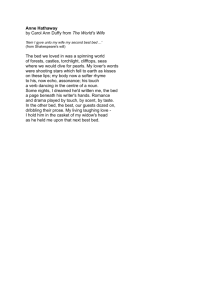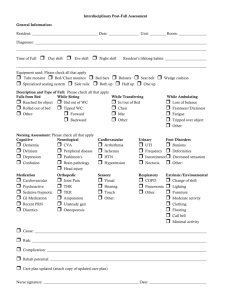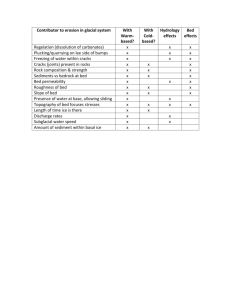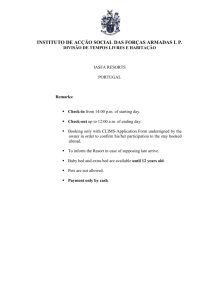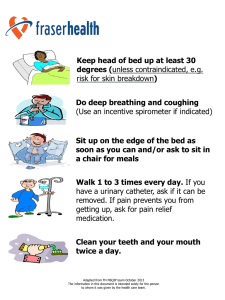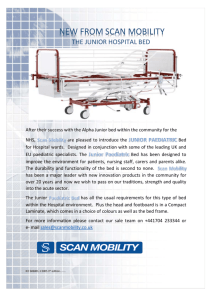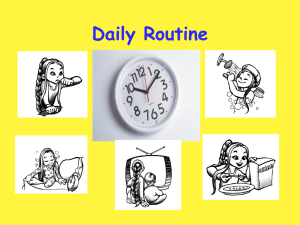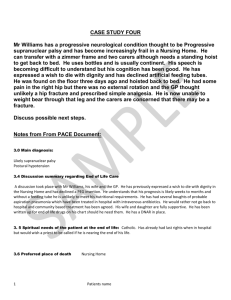Body Mechanics, ROM - Suffolk County Community College
advertisement
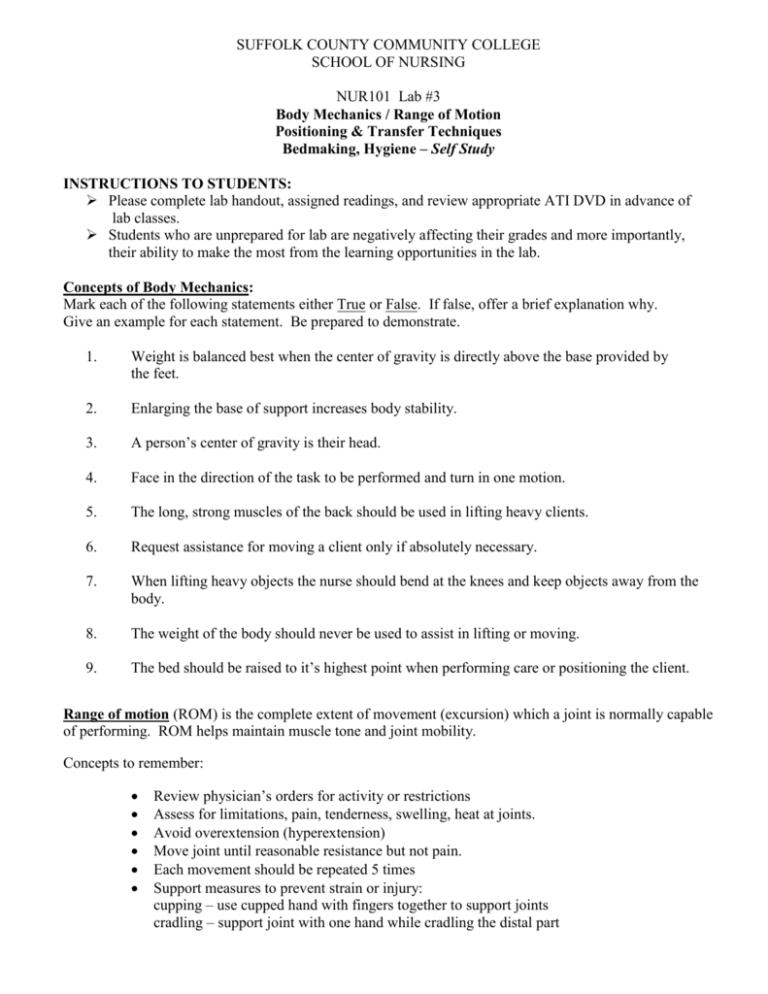
SUFFOLK COUNTY COMMUNITY COLLEGE SCHOOL OF NURSING NUR101 Lab #3 Body Mechanics / Range of Motion Positioning & Transfer Techniques Bedmaking, Hygiene – Self Study INSTRUCTIONS TO STUDENTS: Please complete lab handout, assigned readings, and review appropriate ATI DVD in advance of lab classes. Students who are unprepared for lab are negatively affecting their grades and more importantly, their ability to make the most from the learning opportunities in the lab. Concepts of Body Mechanics: Mark each of the following statements either True or False. If false, offer a brief explanation why. Give an example for each statement. Be prepared to demonstrate. 1. Weight is balanced best when the center of gravity is directly above the base provided by the feet. 2. Enlarging the base of support increases body stability. 3. A person’s center of gravity is their head. 4. Face in the direction of the task to be performed and turn in one motion. 5. The long, strong muscles of the back should be used in lifting heavy clients. 6. Request assistance for moving a client only if absolutely necessary. 7. When lifting heavy objects the nurse should bend at the knees and keep objects away from the body. 8. The weight of the body should never be used to assist in lifting or moving. 9. The bed should be raised to it’s highest point when performing care or positioning the client. Range of motion (ROM) is the complete extent of movement (excursion) which a joint is normally capable of performing. ROM helps maintain muscle tone and joint mobility. Concepts to remember: Review physician’s orders for activity or restrictions Assess for limitations, pain, tenderness, swelling, heat at joints. Avoid overextension (hyperextension) Move joint until reasonable resistance but not pain. Each movement should be repeated 5 times Support measures to prevent strain or injury: cupping – use cupped hand with fingers together to support joints cradling – support joint with one hand while cradling the distal part NUR101 LAB #3 Return joint to neutral position (normal alignment) when finished. Joints are usually exercised sequentially, starting with the neck and moving downward. Muscle tone = residual tension that remains in a normal resting muscle. Muscle strength is graded on a scale of 0 ( Flaccid ) to 5 ( full ROM against gravity, full resistance ). Document limitations to movement in degrees (Ex: R shoulder abduction limited to 30 degrees) ISOMETRIC: tightening muscles without moving body parts. Give 2 examples. 1. _________________________________________________________________ 2. _________________________________________________________________ ISOTONIC: muscle contraction with change in muscle length. AROM (Active Range of Motion) – patient performs ROM independently. Will improve muscle tone and joint mobility PROM (Passive Range of Motion) - nurse moves the joint because the patient can not. Passive ROM will maintain joint mobility. Both will improve cardiovascular function. Joint Movements Be prepared to demonstrate the following movements: Abduction /Adduction Extension / Flexion/Hyperextension Rotation Circumduction Supination / Pronation Opposition Inversion / Eversion Dorsal flexion / Plantar flexion Internal rotation/External rotation Positioning Be prepared to demonstrate the following positions: Supine – Prone – Lateral (side lying) – Sims ( semi prone) – Fowlers position – Be prepared to demonstrate the following positioning techniques necessary to support a client: Trochanter roll. Use of trapeze bar. Use of pillows, towels etc to enhance positioning. Log-rolling: NUR101 LAB #3 Complete the following fill-in: The log-rolling procedure must be utilized for any client with ______________________. A _____________ should be used. A minimum of ________ health care workers (HCW) should perform this procedure. One person ensures a coordinated turn by utilizing a ___________. The client should be turned as one unit, closely and gently. Safe and Effective Transfer Techniques: The goal is to move a patient effectively from one place to another safely. Moving patient’s out of bed (OOB) helps maintain muscle tone, stimulates respiratory and cardiovascular function, helps with elimination and improves psychological well-being. The level of activity is determined by the M.D. order. For ex: OOB with assistance. Nursing assessment and judgment are necessary to determine the best method. Encourage as much participation as possible. Patient should have flat, rubber soled shoed or slippers. Be aware of any tubes patient may have and decide best course of action before the transfer (IV’s, NGT, wound catheter, foley, etc.) Using the nursing process, add additional tasks in the space provided. What do you ASSESS prior to patient: review M.D. order is patient capable of moving all extremities? Identify steps to PLAN the transfer plan technique to be used, inform patient consider if medication will affect balance and judgment What actions will be IMPLEMENTED? lower side rail, raise H.O.B. safety devices in place (w.c. locked) How will you EVALUATE the effectiveness of your actions how did the patient tolerate the transfer examine patient’s position for correct alignment Documentation Mechanical (Hydraulic) Lift: Complete the following fill-in: The hydraulic lift can be used for clients who are incapacitated and cannot weight bear. A minimum of _____ HCWs should perform this procedure. As one HCW operates the lift controls, the other is positioned at the _________ of the client to protect the client. The lift wheels should be _________, and spread in a _______ base of support. Offer reassurance to the client throughout this procedure as it can be very frightening. NUR101 LAB #3 Critical Thinking: The RN delegates to the nursing assistant the task of ambulating a 65-year-old obese client who had a hysterectomy yesterday. This will be the second time the client has gotten out of bed. She has an IV and an indwelling urinary catheter to drainage bag. 1. What steps should the RN and nursing assistant take to prevent client injury? 2. As the nursing assistant is returning with the client to her room after ambulating down the hall, the client begins to feel faint. What actions should be done? Demonstration / Practice: PROM to all body parts supported lateral positioning supported Fowlers positioning sitting in chair moving client up in bed: 1 nurse / 2 nurses log rolling patient in bed dangling bed to chair – 1 assist bed to chair – patient has weakness 1 side – 1 assist ambulate patient: one assist / with IV pole / with walker transfer from bed to stretcher discuss pressure reduction devices Review application of sequential compression device (SCD) and TED support hose Review friction reducing devices Review ATI DVD: Body mechanics, PROM. ceiling lift (MA231) Rev: rmk 6/10 Bedmaking NUR101 LAB #3 Hygiene Needs Self study – to be reviewed with clinical instructor Bedmaking: A. Assessment: Determine activity order. Assess patient. Check condition of linen. Check for any special patient needs. B. Planning: Remember good body mechanics (bend at knees organize work, bed should be raised to appropriate height to prevent back strain). Wash hands Gather linen Clean gloves if soling is likely. C. Implementation: Raise bed to appropriate height for you, the nurse. Remove any attached equipment. Set aside pillows and clean linen to be reused. Loosen linens and remove. Place bottom sheet on bed. Add pull sheet/draw sheet or incontinence pads. Add top sheet and blanket, folding to open bed position. Replace pillows, call bell. D. Evaluation: Bed in correct position for patient needs. Linen change is not routinely documented but tolerance level of patient while out of bed (OOB) may be recorded. E. Postop or Surgical Bed: Top sheet blanket and spread are fan folded for convenient transfer of patient from stretcher to bed. F. Occupied bed: Usually done if patient is too ill to get OOB, or M.D. order is for Bed Rest (B.R.). Safety and comfort of patient is extremely important. The order of activities remains the same as for unoccupied bed. Explain procedure to the patient. If patient is unable to participate another staff member may be needed to assist. At end of procedure always return bed to the low position, with siderails up if needed, and call bell in reach. G. Specialty mattresses: Static Air Mattress, Low-air-loss therapy, Air-fluidized therapy Self Study Page 1 NUR101 LAB #3 Hygiene: Hospitalized patients have at least as many needs as we do for hygiene, sometimes more. Patients may require complete assistance if unable to care for these needs or may require partial assistance Be aware of the patient’s limits, but encourage patient participation. Identify the components of the following: Complete Bed bath including proper water temperature– AM Care – PM Care – Oral Care for a comatose client – Bathing is done to cleanse and condition the skin. Identify (5) other benefits a client derives from bathing. 1– 2– 3– 4– 5– Critical Thinking: Discuss how personal hygiene is influenced by: (list 2 examples of each) Developmental level: Socio-cultural background: Anti-Embolus Devices: Demonstration / Practice: In clinical or in the nursing lab, practice putting on antiembolic stockings (TEDS) and/or venous compression boots (VCB)/sequential support. What is the rationale for use? What concerns would the nurse have about using them? Self Study Page 2 Rev: rmk 6/10
